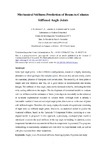Mechanical stiffness prediction of beam-to-column stiffened angle joints

Use este enlace para citar
http://hdl.handle.net/2183/35485
Excepto si se señala otra cosa, la licencia del ítem se describe como CC BY-NC-ND 4.0
https://creativecommons.org/licenses/by-nc-nd/4.0/deed.es
Colecciones
- Investigación (EPEF) [593]
Metadatos
Mostrar el registro completo del ítemTítulo
Mechanical stiffness prediction of beam-to-column stiffened angle jointsFecha
2019-11-28Cita bibliográfica
J.M. Reinosa, A. Loureiro, R. Gutierrez, M. Lopez, Mechanical stiffness prediction of beam-to-column stiffened angle joints, Journal of Constructional Steel Research 168 (2020) 105875. https://doi.org/10.1016/j.jcsr.2019.105875.
Resumen
[Abstract]: Semi-rigid angle joints, in their different configurations, constitute a highly interesting alternative to other typologies like end plate joints. However, they are not widely used in the customary practice of European steel construction. The assembly of these joints is simple and cost effective, and they are a good choice in deconstruction and seismic designs. The stiffness of cleat angle joints can be increased either by preloading the bolts or by adding stiffeners to the angles. The development of theoretical models to evaluate both the stiffness and the resistance of these joints depends essentially on the existence of sufficient experimental evidence to validate them. Although there is already a reasonable number of tests on semi-rigid angle joints, this is not so in the case of joints with stiffened angles. Therefore, this study displays the results of experiments consisting of eight tests on stiffened angle joints. Moreover, an analytical model to predict the rotational stiffness, based on the Eurocode 3 Component Method according to a non-aligned model, is proposed. In this approach, a previously developed plate model is introduced to assess the axial stiffness of the top angle in bending. In addition, a new component that takes into account the stiffener in compression is presented. The proposed methodology is successfully validated with tests from the experimental work, as well as with previous tests from other researchers.
Palabras clave
Angle joints
Rotational stiffness
Semi-rigid joints
Experimental study
Rotational stiffness
Semi-rigid joints
Experimental study
Descripción
Manuscrito aceptado
Versión del editor
Derechos
CC BY-NC-ND 4.0
https://creativecommons.org/licenses/by-nc-nd/4.0/deed.es
ISSN
1873-5983






